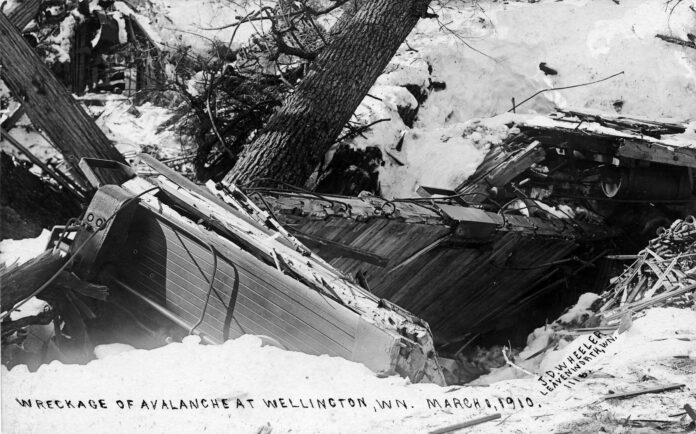Last week’s column documented the huge accumulations of snow that piled up around the town of Wellington where two train loads of passengers, crew, and mail were stranded by intense winter storms during the last week of February 1910. While much of the country was fascinated by the recent appearance of the Great Comet of 1910, and the coming of Halley’s Comet, at the North Cascade railroad station of Wellington, the skies were white as snow. Great Northern Railroad trains had been stuck there for six days, trapped by blizzard conditions that dumped more than 30 feet of snow.
In the early hours of Tuesday, March 1st, a deadly avalanche crushed buildings, locomotives, and passenger rail cars in a matter of seconds. Two trains and a handful of structures were picked up and swept down a canyon 150 feet below the town.
The trains were bound for Seattle. When news of the disaster reached the city, calls went out for workers willing to travel to the carnage and help find survivors. Four homeless men, who each night found free bedding at the city jail, volunteered for the rescue operation. Great Northern was so impressed with their desire to work that the quartet was promised railroad jobs after their service.
The disaster left 96 people dead in its wake, 35 passengers and 61 railway workers and crew. Chelan County Sheriff J.E. Ferguson described the victim’s bodies as, “fearfully distorted and mangled. The heads of some are smashed and limbs are torn in two and the bowels of some are torn out.” There were only 23 survivors. Remarkably, almost all of those rescued suffered only minor injuries. Many survivors were found buried under snow, but alive with little more than bruised and sore bodies. The injured traveled east to Wenatchee, while the dead were sent west by toboggan to the Scenic Hotel which had been transformed into a temporary morgue. The Great Northern Railroad later dedicated a common burial plot in a Seattle cemetery for the unidentified passengers and unclaimed dead.
It took three weeks to repair the tracks before Great Northern’s trains could begin running over Stevens Pass. The Wellington name, by then associated with disaster, was rechristened Tye for the nearby river. To prevent future catastrophes, now sheds were constructed over nine miles of tracks stretching from Scenic to Tye. A new Cascade tunnel was constructed in 1929 and is still in use today by the Burlington Northern Santa Fe Railroad. The old rail grade is now called Iron Goat Trail and provides hiking trails through forests where remains of old rail structures can still be seen. Access is provided from U.S. Highway 2 near the Stevens Pass resort.
This photo number 2017.1.91 comes courtesy of the Washington State Historical Society at 315 North Stadium Way in Tacoma. This two-column series resulted from a suggestion by Tom Cerne. He is a Library Media Specialist for the Federal Way School District who purchased copies of Lauren Tarshis’s children’s book, “I Survived the Wellington Avalanche, 1910” for his students. His father, Louis Cerne (1927-1996) worked as a brakeman, conductor, and engineer for both the Great Northern and Northern Pacific, before they merged with two other railroads in 1970 to create Burlington Northern. Facts about the railroad tragedy came from Don Moody’s 1998 history, “America’s Worst Train Disaster.”








